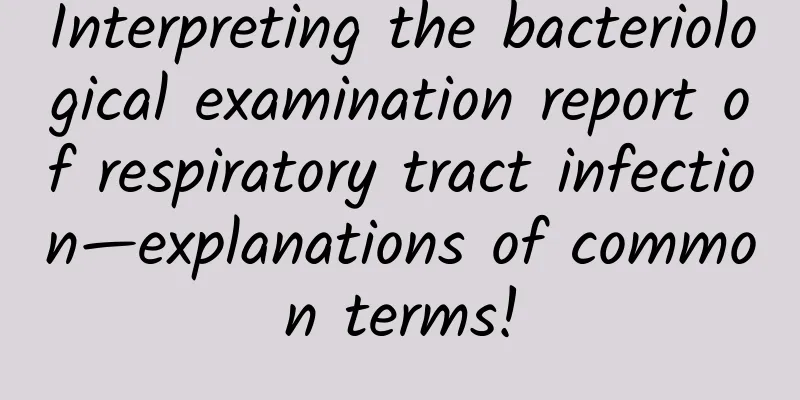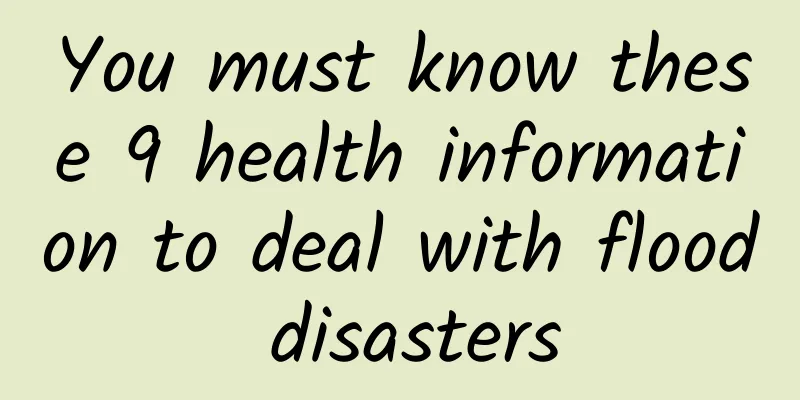Interpreting the bacteriological examination report of respiratory tract infection—explanations of common terms!

|
Author: Lu Binghuai, Chief Physician of China-Japan Friendship Hospital Reviewer: Xiao Dan, Professor of China-Japan Friendship Hospital In the bacteriological examination report of respiratory tract infection, some patients are confused by the unfamiliar terms. Today we will talk about what they mean. Gram-negative cocci or bacilli (+): First, we need to understand a term - Gram staining. Gram staining is a very old staining method, which has a history of more than 100 years since its application. At present, Gram staining is still one of the most commonly used staining methods in microbiology laboratories. It can mainly make different bacteria present different colors. Generally speaking, positive bacteria will appear blue, and negative bacteria will appear red. Based on the staining and the shape of the bacteria, whether spherical or rod-shaped, they are divided into Gram-positive bacilli, Gram-positive cocci, Gram-negative bacilli, and Gram-negative cocci. Through Gram staining and its morphological characteristics, we can roughly infer which type of bacteria it is. Figure 1 Original copyright image, no permission to reprint Gram-negative cocci or bacilli (+) often appear as red bacteria under Gram staining. Depending on the number of pathogens, they can be represented by +, ++, and +++ from few to many, respectively. At most, there may be four "+". The bacteria that cause respiratory tract infections are mainly Gram-positive cocci and Gram-negative bacilli. Among Gram-positive cocci, we are most worried about Streptococcus pneumoniae, which is the most common and easily causes community infections. The next most worried are Staphylococcus aureus, which can cause severe pneumonia, and Streptococcus pyogenes, which causes pharyngeal infections in children. There are many types of Gram-negative rods, including Haemophilus influenzae, Escherichia coli, Klebsiella pneumoniae, Pseudomonas aeruginosa, etc. In addition, Bordetella pertussis is a short Gram-negative rod that can cause whooping cough. Legionella pneumophila can cause Legionnaires' disease. Gram-negative cocci may also cause respiratory tract infections, primarily Moraxella catarrhalis. Gram-positive bacteria rarely cause respiratory tract infections, although some special pathogens can cause them, such as Corynebacterium diphtheriae. In hospitalized patients, those with low immunity, or those with endotracheal intubation, Gram-positive bacteria with weak pathogenicity, such as Corynebacterium striatum, can also cause respiratory tract infections. Epithelial cells or white blood cells> 25/LP: The epithelial cells and white blood cells detected in sputum samples coughed up from the respiratory tract are mainly used to distinguish whether the sample comes from the upper respiratory tract or the lower respiratory tract. For lung infections, pathogens detected in the lower respiratory tract may be the real pathogens. In sputum samples, epithelial cells are the main source of upper respiratory tract infection. If the number of epithelial cells is greater than 25/LP, we usually think that it is from the upper respiratory tract and cannot reflect the situation of lower respiratory tract infection. Those originating from the lower respiratory tract are mainly composed of white blood cells, unless the patient has very low immune function or is granulocytopenic. If the number of white blood cells is greater than 25/LP, we usually think that it comes from the lower respiratory tract and is a qualified sample that can reflect the patient's infection. We need further processing and may detect pathogens. Figure 2 Original copyright image, no permission to reprint Pseudohyphae: occasionally; yeast-like spores: occasionally: This is part of the fungal examination. The shape of the hyphae can be used to distinguish between fungal hyphae and pseudohyphae. Fungal hyphae are common in some filamentous fungi, including Aspergillus, Mucor, Rhizomucor, etc. Pseudohyphae are mainly found in Candida, such as the common Candida albicans, Candida krusei, Candida parapsilosis, etc. When the report shows visible fungal spores and pseudohyphae, it means that Candida is seen in the sample. The presence of Candida in bacteriological examinations of respiratory tract infections usually means that the patient develops dysbacteriosis after using antibiotics. It does not mean that Candida is the real pathogen, because the probability of Candida causing respiratory tract infection is very low. |
<<: What are the symptoms of organophosphorus pesticide poisoning? How to provide first aid?
Recommend
Leucorrhea with blood streaks just after menstruation
If there is blood in the leucorrhea, it is usuall...
Facebook earnings report: users are about to exceed 2 billion, revenue increased by nearly 50%
Facebook's first quarter 2017 financial repor...
What causes nipple rupture?
For female friends, you must pay attention to pro...
Low-sugar fruits suitable for pregnant women
In order to prevent gestational diabetes during p...
What causes ovarian swelling?
Women always have various uncomfortable symptoms ...
Dietary fiber has many benefits. Here’s how to easily eat enough (Part 1)
What is dietary fiber? Dietary fiber is essential...
Women's Day | May every "she" be beautiful and chic
Today is "International Women's Day"...
What are the side effects of taking Fukang tablets?
Medicine is like a double-edged sword. While it h...
What is menopausal neuropathy?
Women may experience a variety of mental problems...
How to effectively relieve itching of vulvar leukoplakia?
Vulvar leukoplakia is a very stubborn disease. Be...
What should I do if my leucorrhea looks like tofu dregs recently?
Female friends often face the troubles of some gy...
What medicine should I take for irregular menstruation?
We all know that delayed menstruation is a seriou...
What to eat for menstrual pain
During or before and after menstruation, women ex...
What causes breast pain ten days before menstruation?
Some women may experience breast pain a few days ...
What is pink bleeding during early pregnancy?
A woman's physical health is very important i...









